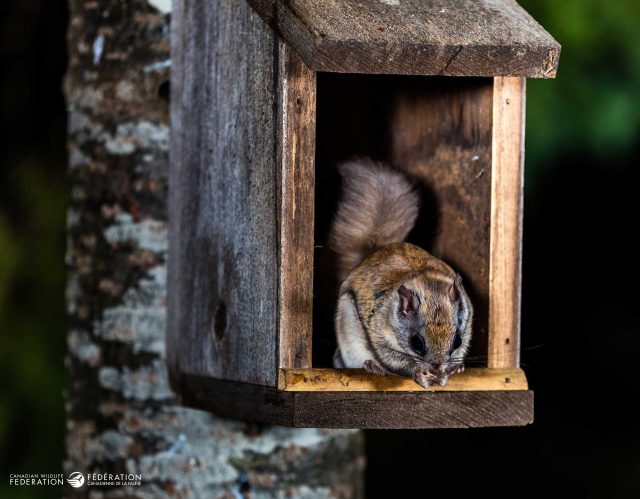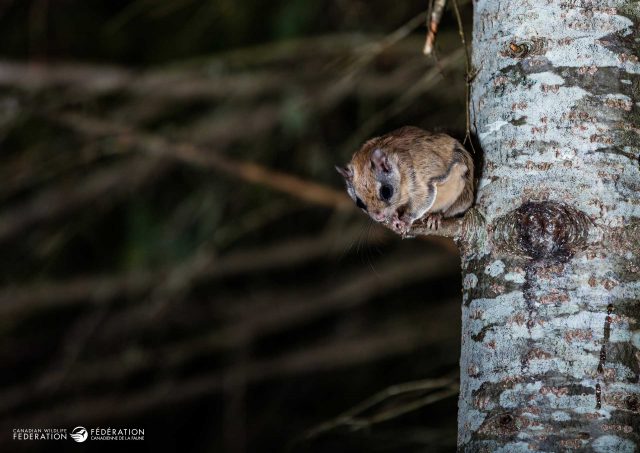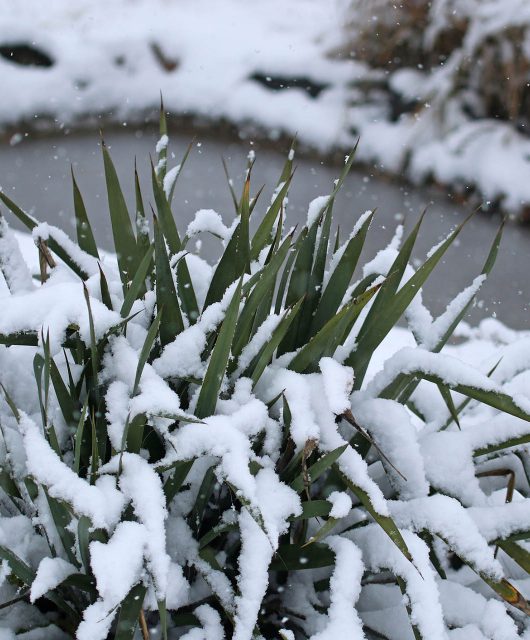It’s a bird! It’s a drone! No, it’s a flying squirrel!
Canada is home to a wide variety of squirrels. You may have seen some of them scurrying along the ground or climbing up and around trees, but two species are not very sure footed, they prefer to glide through the air from tree to tree – say hello to the Southern and Northern Flying Squirrels.
Both Southern and Northern Flying Squirrels are nocturnal species. They have reddish brown to grey fur on their backs and a special membrane called a patagium along their sides. This furred loose membrane of skin can stretch out and help them catch the air, allowing the squirrels to jump and soar 45 metres in a single glide to escape predators and find food. The patagium extends all the way from their wrists of their front legs to their ankles on their hindlegs. They can even make sharp turns up to 180 degrees. While this feat is technically not flying, this special ability is a wonder of nature. With their large, dark eyes and flat tails, these mammals can be found across Canada where there is coniferous and mixed forest. Northern Flying Squirrels are a bit larger than their southern counterparts, averaging 25 to 30 cm in length from their head to end of their tail. They are also more common, occurring throughout most of Canada aside from the prairies and the far north, whereas the southern species is found only in the southern part of Ontario through to the Atlantic provinces. While neither flying squirrel is considered to be at-risk in Canada, these species have been impacted by habitat loss and fragmentation. Here are four ways to help these special critters.
Root for Trees

You can help to conserve the natural habitat for these spectacular species. The mammals are very social and may feed and nest together. They enjoy eating mosses, fungi, lichens, nuts, seeds, leaves, fruit, buds, insects and even bird eggs and small birds. The squirrels do not like to cross open areas, they stick to the forested routes which is why maintaining forest connectivity is so important. They are particularly fond of old growth forests and need cavity trees even in younger forests, so protecting these is crucial.
Branching Out

Flying squirrels use tree cavities for den sites but they will also build nests out of twigs and other material. You can help flying squirrels by leaving dead standing trees (snags) and large old trees in place whenever possible. Planting native trees will help improve canopy cover and provide food sources. Depending where you live, spruce, cedar, aspen, birch, pine, oak, beech or maple may be suitable trees to plant. Flying squirrels will use nest boxes, there have even been reports of them using bluebird boxes. Placing nest boxes in a wooded area increases their chances of being used. Nest boxes for flying squirrels do not need perches. In fact, perches can actually put them more at risk of predation. Their nesting boxes should have a slanted roof, be made from untreated softwood, be waterproof, and have climbing notches or grooves on the walls for pups to climb.
Natural Solutions
There are many things you can do naturally to keep flying squirrels safe. Firstly, avoid using pesticides as these can harm our furry friends. You’ll also want to keep your cat indoors to avoid flying squirrels in your yard from falling prey to your pet. And think twice before you remove things from your area. If you live near a mature forest with a stream or even a swamp, these areas are beneficial to flying squirrels. Similarly, don’t remove dead trees or fallen logs from you property — these are great sources of shelter and food.
Help Scientists by Sharing Observations
If you are lucky enough to see a flying squirrel, let us know. They are nocturnal so seeing one can be a bit tricky. Share your photos on the iNaturalist app or iNaturalist.ca website. Your observations will be available to be reviewed by scientists and may even become part of critical research projects. To date there are more than 1,300 observations of flying squirrels in the Canadian database.




